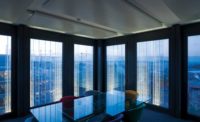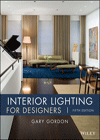Lighting Design Firm 8’8” Illuminates the Renewed Bibliothèque Nationale de France
Paris

The world’s oldest mandatory-deposit library, the Bibliothèque Nationale de France (BNF), conserves not only the nation’s printed matter but also fine collections of coins, medals, engravings, maps, manuscripts, and musical scores. Between 1720 and 1998, all of its holdings were kept at a site in the heart of Paris, between the rues Vivienne and de Richelieu, in a jumble of buildings (including Cardinal Mazarin’s palace) that were famously remodeled by Henri Labrouste in 1854–68. With the exponential expansion of its collections in the 20th century, the BNF became desperately short of space, which prompted construction of Dominique Perrault’s giant library building in Paris’s 13th arrondissement (1988–96). While the majority of the printed matter moved there, everything else—around 20 million objects—remained at the Richelieu site, which also became home to the National Institute of Art History. In 2007, a major overhaul and refurbishment was begun by L’Atelier Gaudin Architectes (AGA), in two phases, the first completed in 2016 and the second last September. Accompanying AGA throughout this 15-year adventure was Paris-based lighting designer 8'18", which oversaw illumination for the entire 743,000-square-foot complex.
“For us, the BNF was like a giant case study, with countless projects within the project,” says 8'18" partner Emmanuelle Sébie. After a detailed analysis of the existing systems and fixtures, which included interviewing all those working in the restoration workshops about their individual needs, 8'18" established a catalogue of off-the-shelf, adapted-readymade, and 100-percent custom solutions according to three main criteria: functional lighting (corridors, workspaces, reading desks, etc.), conservancy lighting (bookstacks and museum storage), and architectural-feature lighting.

1
8'18" created custom solutions for the Galeries Mazarine (top of page) and Mansart (2) that highlight ceiling art while, for reading and workrooms (1), devising discreet, functional lighting. Photos © Sébastien Veronese (1), 8'18 (2)

2
“We had to find our place in spaces with a very strong character,” recalls Sébie. “We tried to recount the architecture through the lighting.” In the Galerie Mazarine, for example, the only part of the cardinal’s palace to survive intact, 8'18" persuaded the BNF to remove the imposing chandeliers (which, though historic, were not designed for the space) and instead install cornice-mounted lighting that allows uninterrupted appreciation of the beautifully restored blues and pinks of Gian Francesco Romanelli’s ceiling frescos. In the Galerie Mansart just below, which the BNF uses for temporary exhibitions, 8'18" removed a technical-lighting gantry, which they felt prevented a proper reading of the vault, and replaced it with wall-mounted brackets whose forms echo the painted ceiling cartouches. Because of the heavy projectors their 6-foot cantilever must carry, the brackets are set 1 foot into the stonework.

3

4
In the Salle Ovale, curved mirrorfinished steel bars house spots (3), while LEDs behind ceiling oculi (4) sparkle from above. Photos © Sébastien Veronese (3), 8'18 (4)

A cross section of the new open-plan hall (below) reveals how daylight, combined with strategically placed luminaires, lights the circular steel-andaluminum escalier d’honneur that penetrates the heart of the building (above).
One of the revelations of phase two of the revamp, the Salle Ovale (designed by Jean-Louis Pascal, Labrouste’s successor, and built in 1897–1932) “was a textbook case on its own, given all the different lighting situations,” says Sébie. Besides restoring the historic reading lamps and illuminating the wall-mounted shelving with discreetly integrated sources, 8'18" designed museum lighting for displays installed near the entrance: suspended 59 feet from the ceiling, giant mirror-finished stainless-steel bars contain spots directed toward the presentation cases. Several prototypes were required to perfect their curvature, which echoes the oval of the hall. Then there was the question of what to do with the monumental glass skylight and glass-filled oculi. “Bruno [Gaudin] couldn’t bear the idea of their becoming black holes after dark,” recalls Sébie. In response, 8'18" installed projectors above the skylight, which turn the steel roof frame into a ghostly nighttime presence, and fixed a series of LED constellations to the upper side of the oculi—a technically complex, bespoke installation—which they programmed to twinkle in different spatial sequences.
Together with AGA, 8'18" developed countless solutions for the BNF that range from the spectacular, like the daylight-effect illumination of the escalier d’honneur, to the discreet, such as the 8,000 corridor lights whose polycarbonate shades are engraved with images representing all the different departments housed at the Richelieu complex. “What was both wonderful and extremely difficult was finding a suitable narrative,” concludes Sébie. “The BNF was an incredibly complex and enriching undertaking.”
Click section to enlarge

Read more about lighting projects from the February 2023 Issue
Credits
Architect:
Atelier Bruno Gaudin — Bruno Gaudin, Virginie Bregal, principals; Raphaële Le Petit, Olivier Peyrard, project architects
Lighting Designer:
8'18" — Georges Berne, Emmanuelle Sébie
Engineer:
EGIS
Consultant:
Eiffage Energie Systèmes (lighting contractor)
Clients:
French Ministries of Culture; Education; and Higher Education, Research and Innovation
Owner:
Bibliothéque Nationale de France
Size:
740,000 square feet
Total Lighting Cost:
$4 million
Completion Date:
2022
Sources
Lighting:
Secante; Modular Lighting Instruments; LED Linear; Regent Lighting; DGA; SPX Lighting; OPTYLED; Delta Light






